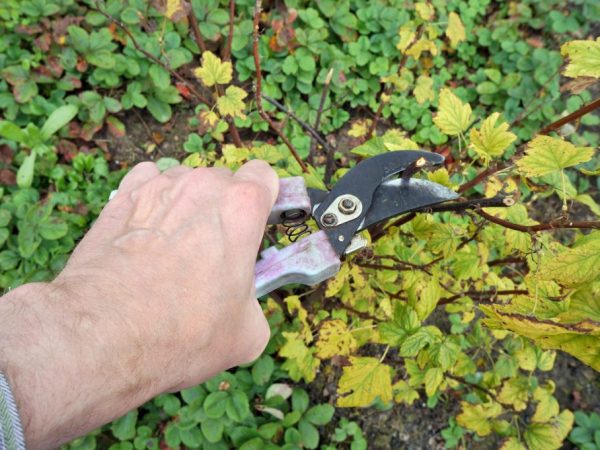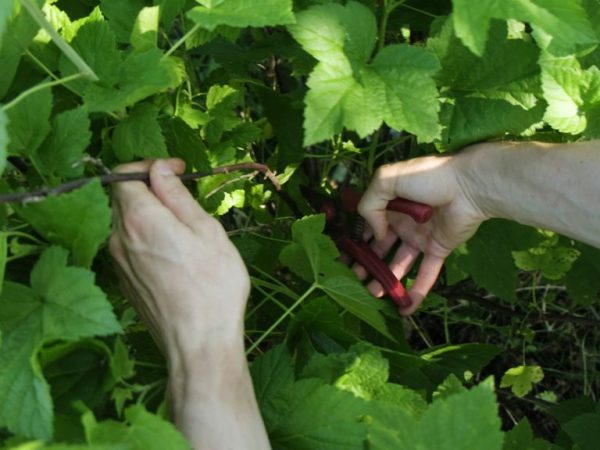Pruning currants in the fall - basic rules
Currant is an unpretentious crop to care for, it does not require excessive care, while giving a good yield. To ensure a comfortable growth, pruning should be done (preferably in the fall), thanks to which the plant will endure the winter and will please with an abundance of berries in the next season.

Pruning currants in the fall - basic rules
Purpose of the procedure
Pruning a fruit tree is done in pursuit of several goals:
- Stimulation of the formation of young shoots. As a result, a rejuvenating effect is achieved by replacing old, less productive shoots with new ones that are capable of harvesting with full force.
- Normalization of crown aeration and supply of the required amount of light. In the course of cutting shrubs, crowding is eliminated, the risks of infectious diseases are minimized.
- Increased productivity. In the absence of old branches, the plant uses its forces not to provide them, but to form and further develop the ovaries.
- Pest prevention. With a systematic correction of the green mass, the likelihood of damage to healthy segments by insects is minimized.
- Facilitate harvesting.
- Increase the fruiting period by up to 20 years.
Benefits of Autumn Pruning
There are many disputes about the most favorable time for pruning, due to the diversity of the climate in Russia.
In the spring. The downside is the tight deadlines. They should be carried out before the formation of fresh buds, which is not always realistic due to natural conditions. Cutting during sap flow is fraught with a violation of the development cycle of the bush. But such a correction allows you to correctly assess the degree of pruning, because the branches are not hidden by the foliage.
In summer. Shearing is done only in extreme cases - if it is necessary to eliminate infected shoots or to stimulate fruiting by pinching the shoots for a maximum of 2 buds. However, this procedure has more negative consequences:
- wounds remain moist for a long time, which helps to attract pathogenic bacteria;
- the currants may not have enough strength to grow new shoots, so the next season the risk of getting a weakened berry increases;
- young shoots do not have time to prepare for winter and die as a result.
In the autumn. Currant pruning is carried out exclusively after the sap flow has stopped, which allows the culture to calmly transfer the procedure and enter the hibernation period without a stressful state. In case of uncertainty, it is allowed to cut the branch - if drops of liquid are noticeable, the date of the haircut is shifted by a week.
Provided the procedure is correct, new shoots are stimulated, which by spring are successfully replacing unproductive ones.In addition to rejuvenation, this relieves the plant of parasites that can penetrate the soil before the onset of frost and subsequently harm healthy bushes.
Optimal timing
Despite the fact that autumn is more for the correction of currants, a number of other nuances should be taken into account that affect the speedy recovery of the bush.
Moon calendar
Focusing on the moon, you can determine the timing of summer cottage work. Descending, 3 or 4 phases are the best periods for a haircut.
The most favorable days in 2019:
- in September - 2, 5, 7, 9;
- in October - 1, 4, 5, 10, 29, 31;
- in November - 3, 7, 8, 11, 28, 30.
Growing regions
To determine the time of cutting currants in the autumn, it is worth considering the climatic conditions of the territory.
- The Moscow region is characterized by rapid soil freezing. Therefore, the events need to be completed by the end of October.
- In the Leningrad region, the procedure will begin on October 15.
- Siberia is characterized by sharp jumps in temperature, which results in faster preparation of plants for the onset of cold weather. The best time is the first days of September.
Description of technology

The instrument must be disinfected
There are several ways to trim, each with a specific purpose.
| Trim type | Features of the |
| Sanitary | It involves the elimination of all unnecessary processes - injured, dry, damaged by pests. Breaking branches with your hands, while leaving hemp, is strictly prohibited due to the emerging threat of the spread of rot |
| Rejuvenating | The main goal is to increase yields. The need is due to the ability of the plant to form the largest number of berries only on shoots about 3 years old. During the procedure, the old branches are completely cut down, which take away all the juices and powers of the currants for their life support. |
| Formative | Allows to achieve uniform fruiting and aesthetic appearance. One of the tasks is to prevent the spread of overgrowth beyond the already formed crown. Carried out throughout the life of the culture |
| Topping | Only suitable for black currants. It involves the removal of the upper parts with pruning shears to a length of up to 5 cm.It is carried out with a sanitary and anti-aging purpose |
In the fall, they do sanitary and rejuvenating currant pruning. Carry out exclusively sharpened and disinfected tools: pruning shears, garden saw and scissors.
Black currant pruning
In order for a haircut to bring benefits to the shrub and allow it to endure the winter without complications, they follow this scheme:
- The plant is carefully examined for the presence of disease-damaged and broken shoots, they are eliminated first.
- Too long branches located on the surface of the ground are cut off. The latter are shortened by 3-4 formed buds.
- Segments that are more than 3 years old are cut. You can determine the degree of maturity of the shoot by the color of the bark - over time, it becomes darker. Rejuvenation is carried out only after 5 years of the life of the bush. To do this, cut off the old branches at the base, having previously bent to the ground. If a stump has been left, the risk of pests affecting the currant increases, so it is recommended to prune it on a ring.
- Branches growing towards the center and thickening the crown are eliminated, as well as zero shoots and all new growth shorter than 15 cm. Unproductive segments are cut off completely or by 4 buds.
- Treat the wounds of cut bushes with garden pitch.
Often novice gardeners make a number of mistakes in caring for currants, the most common are the removal of tops or mass pruning of young shoots. As a result, the plant's immunity to diseases and productivity are significantly reduced.
It is important to adhere to certain rules regarding the age of the culture:
- In the first year, the need for an event is determined by the cultivated variety.Abundantly fruiting crops are pruned by a maximum of 20%, poor crops should not be adjusted.
- For 2 years, 3-4 powerful segments are left, sanitary and formative pruning is done.
- For 3-4 years, only the branches that require elimination are removed.
- Five-year-olds are sheared every season, keeping 2-3 shoots of different ages.
Pruning red and white currants

Red currants are cut at 8 years of growth
Haircut rules are different from those that apply to black correction. This is due to the degree of ripening and the place of formation of fruit bearing on the shoots.
Features:
- Anti-aging procedures are carried out not for 5, but for 6-8 years, removing old segments in the root area.
- In the course of formation, non-fruiting branches up to 15 cm long are removed. Elimination of 2-3-year-old shoots is not necessary.
- High yields are achieved by keeping more than 15 uneven-aged shoots on one bush.
- The lateral segments are cut by ½, the basal segments are left in the amount of 3 pieces.
When cultivating red currants, it is required to closely monitor the development of the plant and make a shaping correction only if the berry did not give the expected results during the growing season.
Bush formation methods
The classical cultivation method involves the formation of the type of a standard bush. It is suitable for novice gardeners.
However, there are a number of more bizarre plant forms that are gaining more and more popularity every year.
Standard currant
As a result of following this scheme, very attractive outwardly currant trees are obtained, especially impressive during the fruiting period:
- In the first year after planting, standard pruning is performed, while removing part of the growth to 1 bud facing outward.
- Six months later, all young shoots on the trunk and zero shoots are eliminated.
- After 12 months, the entire growth is cut off on the main branches. The rest are shortened to 5 cm (then their size is increased to 10 cm).
- For the next spring, the side segments are cut to 3 cm, which are further trimmed to 25. In addition, too thick branches are removed.
Michurin method
A quite simple scheme recommended for use by novice agronomists, the essence of which is as follows:
- Bushes begin to cut off only from the 5th year of life, while removing half-diseased, injured and thickening shoots. After that, you need to feed the plant with fertilizers so that it can recover from stress faster.
- A year later, all branches are cut down, selecting and leaving 20 strong and fairly young segments.
- In the next season, cut down another half of the shoots, save only 10. Those specimens that are 5 or more years old are completely removed. Cut branches in injured places are covered with garden pitch.
On the trellis
The method helps to improve the quality of fruits due to the degree of yield. Despite the small amount, the berries grow large and excellent in taste.
Trimming currants under a trellis is carried out as follows:
- Immediately after planting, the lateral processes are shortened to 5 cm - this allows the buds to be transferred to the fruiting mode.
- Trim all branches on the surface of the soil without affecting the main trunk. If the plant has 2 or more central branches, choose the strongest one. In the future, the root and segments close to the ground are removed.
Follow-up care
With the onset of autumn, part of the foliage is still preserved on the currant bushes, so the spread of diseases and harmful insects should be prevented. To do this, use Bordeaux liquid at a concentration of 1% to process the green mass of the shrub. Do not neglect the cleaning of the waste remaining after trimming.
Additionally, the surface of the substrate in the near-stem region is loosened with a pitchfork or a rake, stepping back about 20 cm from the base. This allows the supply of the required amount of oxygen to the root system.
To achieve maximum efficiency when loosening, a potassium-phosphorus mixture is embedded in the soil. It is also allowed to dig in rotted manure around the perimeter at a distance of 30 cm from the plant.

